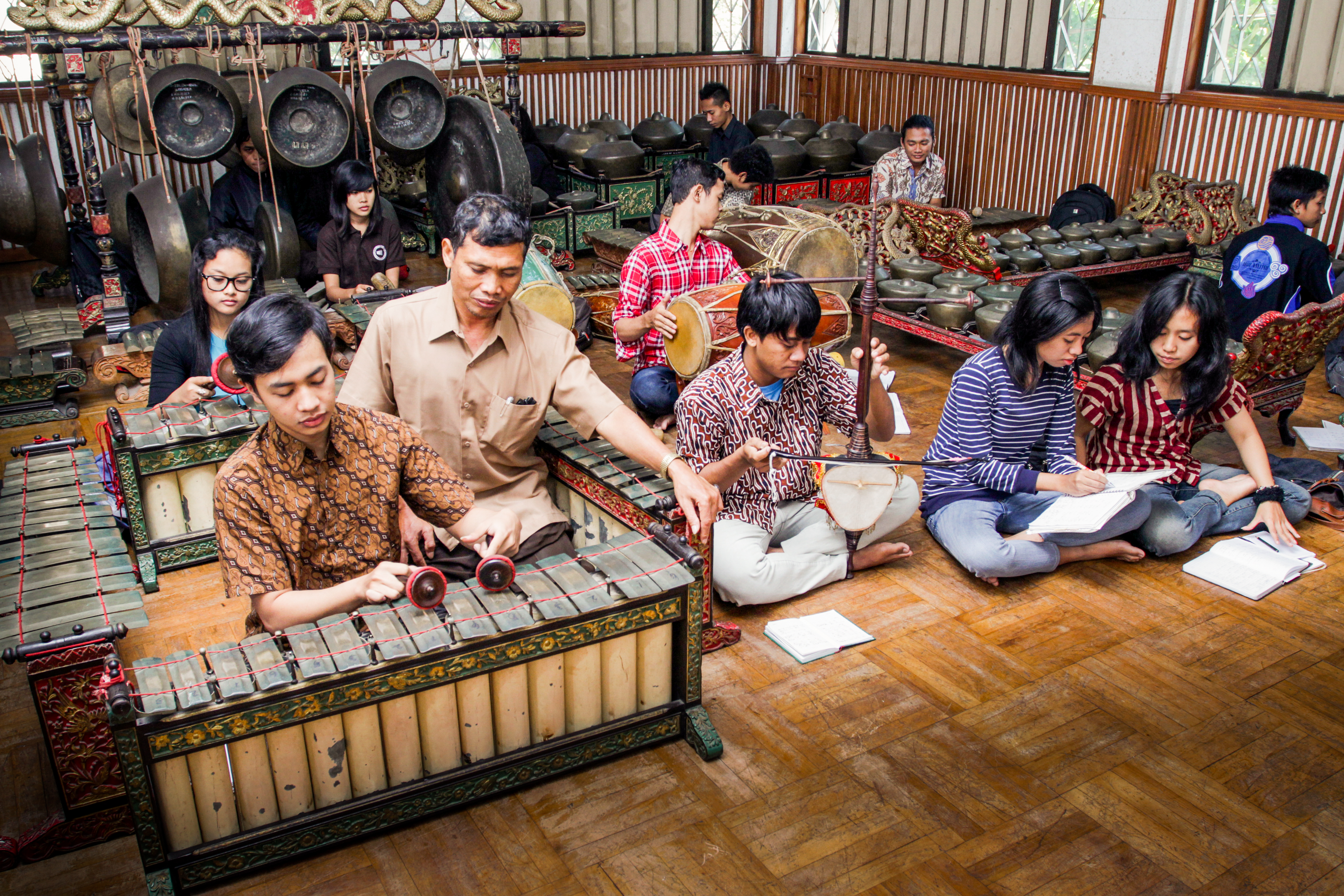
Gamelan reflects three significant aspects of material, music, and function. Gamelan is the percussion orchestra of Indonesia. Gamelan is a set of traditional music instruments mostly made of hand-forged metal (bronze, brass, and iron). Gamelan consist of slab-type (wilahan) instruments: saron/sarun/pemade, demung/sarun ganal, gender/kiliningan, slenthem/selentem/jegogan, peking/sarun paking/kantilan, kecrek/keprak, and gong-type (pencon) instruments: gong, kempul, kenong, bonang, trompong, kethuk, and kempyang. Other instruments, e.g., zither and seruling (bamboo flute). Gamelan instruments are played by beating (gong, saron, demung, slenthem, kecer); plucking and strumming (siter, kecapi, rebab); tapping (kendang); and blowing (flute). The pitch and tuning of gamelan are slendro and/or pelog (pentatonic and/or heptatonic), each has its own frequency and interval pattern. Lower and higher pitched instrument pairs, together, they produce Indonesian Gamelan melodies, which resonate the sound of ombak (beats) or pelayangan (vibrato). Gamelan music has its own techniques and forms, i.e., one melody performed simultaneously by the different instruments (heterophony), the technique of interlocking multiple instruments to structure their rhythms (interlocking part), and the rhythmic and metric patterns of beat and punctuation (colotomic punctuation).
Gamelan is used for human life-cycle rituals and ceremonies, mental-health therapy and other purposes, e.g., to refine character, develop life skills, increase study concentration, self-confidence and motivation. As entertainment, Gamelan is performed at music concerts, theatres, and other artistic expressions.
Archaeological evidence of gamelan was found in the bas-reliefs of the 8th-century Borobudur temple. Gamelan is widely known in Indonesia and abroad, like the U.S.A., Japan, the Netherlands, the U.K., France, Australia, Malaysia, and China
Gamelan can equally be performed by both men and women, children and adults, is part of customary and religious ceremonies, and contemporary performing-arts. Gamelan tradition-bearers are: Mpu (master creator and performing-arts): a person with high-degree of dexterity, manner, and creativity in karawitan (classical gamelan); a master of gamelan performance, who emphasises the aspects of spiritual, technological, material, size, and voice-quality; a master of gamelan making process, who has cultural competence, sustainable artistic ethos, notable artworks as sources of creativity and technique for the community; Teacher/Trainer/Penguruk: those who teach students the manner, knowledge and skills of gamelan performance; Training Assistance: teaching assistant; Student/Cantrik: those who receive lessons on manner, knowledge, and skills of gamelan performance.
Gamelan players/practitioners, called pengrawit/nayaga/niyaga/wiyaga/penabuh/juru-nabeuh/juru-tabuh/penggamel/panggamalan/panjak, consist of: Miji (Gẽnder and Gender Penerus (metallophones), Kendang (drums), Rebab and Siter (bowed and plucked strings), Gambang (xylophones), and flutes); Penabuh (Bonang, Demung, Saron, peking/penerus, slenthem, kethuk, kenong, kempul, gong); Panji, the master gong-smith in besalen (gamelan workshops), knowledgeable about tin and copper smelting, melting, and casting techniques; Pande, a gong-smith, gamelan instrument maker (forging/casting); Pelaras, a tuner to produce the exact tuning desired; Pengukir, a wood-carver whose artistic carvings adorn the rancakan (racks/resonating frames) of gamelan instruments; Penyungging, a person colouring the rancakan woodcarvings of gamelan instruments; and Perakit, a person who assemble rancakan of each gamelan instrument; Sinden/Juru Kawih (singer/song artisan), typically women; and additional male soloist/vocalists called Wira Swara/Juru Alok besides sinden. Lurah Sekar, Pengesuh/Tindhih/KelianGong, a group leader in gamelan performance, responsible for gamelan practice and transmission.
Disetujui Oleh WBTB Pada Tanggal 27-03-2020

Nama :
Sanggar Garasi Seni Benawa
Alamat :
Karanganyar, Surakarta, Jawa Tengah
Telp/Fax/HP :
62816677490
Website :
-
Email :
-

Nama :
Sanggar Arma
Alamat :
Peliatan UBUD
Telp/Fax/HP :
6282237662499
Website :
-
Email :
-
| # | Tahun | No. Pencatatan | Nama Karya Budaya | Profinsi | Domain |
|---|
| # | Tahun | No. Penetapan | Nama karya Budaya | provinsi | Domain |
|---|

© 2018 Direktorat Warisan dan Diplomasi Budaya